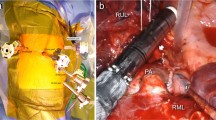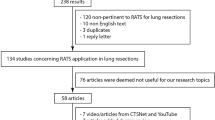Abstract
Purpose of Review
Although surgery for lung cancer was not common before the early twentieth century, it has enjoyed remarkable progress since then both in type of resection and technical approach. This has been coupled with significant technological advances. Here, we will review the history and evolution of this relatively new field of surgery.
Recent Findings
The gold standard of the extent of resection for lung cancer evolved from pneumonectomy to lobectomy to even sublobar resection for select situations. In addition, major advances have occurred in the technical aspect of the surgical procedure. The incisional approach has evolved from rib spreading thoracotomy to thoracoscopic surgery with the latter showing significant improvement in short-term outcomes over open thoracotomy. However, standard video-assisted thoracoscopic surgery or VATS is associated with visual and mechanical limitations, including lack of depth perception and rigid straight instruments. This makes it appropriate only for early-stage peripheral and small tumors. Most of the limitations of VATS can be overcome with the more recently introduced robotic-assisted thoracic surgery (RATS). RATS utilizes wristed instruments that are introduced in the chest through 8-mm ports and can mimic the movements of the human hand. In addition, magnified, three-dimensional and high definition imaging gives the surgeon an image of the lung unlike any other modality. This has allowed surgeons to perform advanced resections such as pneumonectomy or sleeve resection in a minimally invasive fashion. In addition, RATS has become a platform for the addition of other technical enhancements such as incorporating a near infra-red light source into the camera allowing identification of autoflourescent agents, such as indocyanin green. This has allowed localization of small nodules for resection and identification of tissue planes for sublobar resection. However, new technologies also require investments in time and money.
Summary
Thoracic surgery for lung cancer has evolved to include advanced minimally invasive techniques including video-assisted and robotic-assisted thoracoscopy. RATS in particular may enable surgeons to perform more advanced procedures in a minimally invasive fashion. It is hoped that the higher costs of new surgical technology may be offset by the potential for improved patient outcomes and resultant socioeconomic benefits.

Similar content being viewed by others
References
Papers of particular interest, published recently, have been highlighted as: • Of importance •• Of major importance
Naef AP. Development of thoracic surgery from 1880 to the present. Rev Med Suisse Romande. 1987 Nov;107(11):949–57.
Guedel A, Waters R. A new intratracheal catheter. Anesth Analg 1928;7:238–9. 1928;7:238–9.
Gale J, Waters R. Closed endobronchial anesthesia in thoracic surgery. J Thorac Surg 1931;1:432–7. 1931;1:432–7.
Graham EA. The first total pneumonectomy. Tex Cancer Bull. 1949;2(1):2–4.
Ochsner A, Debakey M. Primary pulmonary malignancy: treatment by total pneumonectomy; analysis of 79 collected cases and presentation of 7 personal cases. Ochsner J. 1939;1(3):109–25.
Cahan WG. Radical lobectomy. J Thorac Cardiovasc Surg. 1960;39:555–72.
Shimkin MB, Connelly RR, Marcus SC, Cutler SJ. Pneumonectomy and lobectomy in bronchogenic carcinoma. A comparison of end results of the Overholt and Ochsner clinics. J Thorac Cardiovasc Surg. 1962;44:503–19.
Jensik RJ, Faber LP, Milloy FJ, Monson DO. Segmental resection for lung cancer. A fifteen-year experience. J Thorac Cardiovasc Surg. 1973;66(4):563–72.
Bennett WF, Smith RA. Segmental resection for bronchogenic carcinoma: a surgical alternative for the compromised patient. Ann Thorac Surg. 1979;27(2):169–72.
Errett LE, Wilson J, Chiu RC, Munro DD. Wedge resection as an alternative procedure for peripheral bronchogenic carcinoma in poor-risk patients. J Thorac Cardiovasc Surg. 1985;90(5):656–61.
Miller JI. Hatcher CR,Jr. limited resection of bronchogenic carcinoma in the patient with marked impairment of pulmonary function. Ann Thorac Surg. 1987;44(4):340–3.
Read RC, Yoder G, Schaeffer RC. Survival after conservative resection for T1 N0 M0 non-small cell lung cancer. Ann Thorac Surg. 1990;49(3):391,8 discussion 399-400.
Pastorino U, Valente M, Bedini V, Infante M, Tavecchio L, Ravasi G. Limited resection for stage I lung cancer. Eur J Surg Oncol. 1991;17(1):42–6.
Ginsberg RJ, Rubinstein LV. Randomized trial of lobectomy versus limited resection for T1 N0 non-small cell lung cancer. Lung Cancer Study Group. Ann Thorac Surg. 1995;60(3):615,22; discussion 622-3.
Abbas AE. Ground glass opacity of the lung: the veil that needs lifting. J Thorac Cardiovasc Surg. 2017;154(6):2100–1.
Suzuki K, Koike T, Asakawa T, Kusumoto M, Asamura H, Nagai K, et al. A prospective radiological study of thin-section computed tomography to predict pathological noninvasiveness in peripheral clinical IA lung cancer (Japan clinical oncology group 0201). J Thorac Oncol. 2011;6(4):751–6.
Cao C, Chandrakumar D, Gupta S, Yan TD, Tian DH. Could less be more?-a systematic review and meta-analysis of sublobar resections versus lobectomy for non-small cell lung cancer according to patient selection. Lung Cancer. 2015;89(2):121–32.
Kodama K, Doi O, Higashiyama M, Yokouchi H. Intentional limited resection for selected patients with T1 N0 M0 non-small-cell lung cancer: a single-institution study. J Thorac Cardiovasc Surg. 1997;114(3):347–53.
Matsumura Y, Yano M, Yoshida J, Koike T, Kameyama K, Shimamoto A, et al. Early and late recurrence after intentional limited resection for cT1aN0M0, non-small cell lung cancer: from a multi-institutional, retrospective analysis in Japan. Interact Cardiovasc Thorac Surg. 2016;23(3):444–9.
Nakamura K, Saji H, Nakajima R, Okada M, Asamura H, Shibata T, et al. A phase III randomized trial of lobectomy versus limited resection for small-sized peripheral non-small cell lung cancer (JCOG0802/WJOG4607L). Jpn J Clin Oncol. 2010;40(3):271–4.
Landreneau RJ, Mack MJ, Hazelrigg SR, Naunheim K, Dowling RD, Ritter P, et al. Prevalence of chronic pain after pulmonary resection by thoracotomy or video-assisted thoracic surgery. J Thorac Cardiovasc Surg. 1994;107(4):1079,85 discussion 1085-6.
Jaklitsch MT. DeCamp MM,Jr, Liptay MJ, Harpole DH,Jr, Swanson SJ, Mentzer SJ, et al. video-assisted thoracic surgery in the elderly. A review of 307 cases. Chest. 1996;110(3):751–8.
Demmy TL, Curtis JJ. Minimally invasive lobectomy directed toward frail and high-risk patients: a case-control study. Ann Thorac Surg. 1999;68(1):194–200.
Kaseda S, Aoki T, Hangai N, Shimizu K. Better pulmonary function and prognosis with video-assisted thoracic surgery than with thoracotomy. Ann Thorac Surg. 2000;70(5):1644–6.
McKenna RJ Jr, Houck W, Fuller CB. Video-assisted thoracic surgery lobectomy: experience with 1,100 cases. Ann Thorac Surg. 2006;81(2):421,5 discussion 425-6.
Amosov NM, Berezovsky KK. Pulmonary resection with mechanical suture. J Thorac Cardiovasc Surg. 1961;41:325–35.
Ravitch MM, Steichen FM, Fishbein RH, Knowles PW, Weil P. Clinical experiences with the soviet mechanical bronchus stapler (Ukb-25). J Thorac Cardiovasc Surg. 1964;47:446–54.
Acuff TE, Mack MJ, Landreneau RJ, Hazelrigg SR. Role of mechanical stapling devices in thoracoscopic pulmonary resection. Ann Thorac Surg. 1993;56(3):749–51.
Abbas AE. Robotic portal lobectomy, surgery through a virtual thoracotomy. J Thorac Dis. 2017;9(9):2871–5.
Cerfolio RJ, Bryant AS, Skylizard L, Minnich DJ. Initial consecutive experience of completely portal robotic pulmonary resection with 4 arms. J Thorac Cardiovasc Surg. 2011;142(4):740–6.
Kent M, Wang T, Whyte R, Curran T, Flores R, Gangadharan S. Open, video-assisted thoracic surgery, and robotic lobectomy: review of a national database. Ann Thorac Surg. 2014;97(1):236,42 discussion 242-4.
•• Park BJ, Melfi F, Mussi A, Maisonneuve P, Spaggiari L, Da Silva RK, et al. Robotic lobectomy for non-small cell lung cancer (NSCLC): long-term oncologic results. J Thorac Cardiovasc Surg. 2012;143(2):383–9 This is the largest study to date of the long term oncologic effects of robotic surgery for lung cancer. It showed that long-term stage-specific survival for robotic lobectomy is acceptable and consistent with prior results for VATS and thoracotomy.
Louie BE, Farivar AS, Aye RW, Vallieres E. Early experience with robotic lung resection results in similar operative outcomes and morbidity when compared with matched video-assisted thoracoscopic surgery cases. Ann Thorac Surg. 2012;93(5):1598,604 discussion 1604-5.
Maria Shulman R, El-Sayed Abbas A. The state of the art and future directions of robotic-assisted thoracic surgery. https://doi.org/10.1007/s12055-017-0626-7. IJTCVS. 2018 January, 2018;34(S1):55.
• Cerfolio R, Louie BE, Farivar AS, Onaitis M, Park BJ. Consensus statement on definitions and nomenclature for robotic thoracic surgery. J Thorac Cardiovasc Surg. 2017 23. This paper attempts to standardize the nomenclature used in defining the type of operation performed during robotic lung surgery.
Abbas AE. New nomenclature for robotic-assisted thoracic surgery also gets rid of RATS. J Thorac Cardiovasc Surg. 2017 Apr;2.
• Abbas A, Kadakia S, Ambur V, Muro K, Kaiser L. Intraoperative electromagnetic navigational bronchoscopic localization of small, deep, or subsolid pulmonary nodules. J Thorac Cardiovasc Surg. 2017 7. This paper provides the first description of using near infra red light and autoflourescence for localization of lung nodules during robotic lung surgery.
Shen J. Prof. Abbas E. Abbas: a robotic thoracic practice can provide both clinical and financial benefits for an academic institution. J Thorac Dis. 2017 Jun;9(6):E573–5.
Author information
Authors and Affiliations
Corresponding author
Ethics declarations
Conflict of Interest
Abbas E. Abbas has received compensation from Intuitive Surgical, Inc. for service as a consultant.
Human and Animal Rights and Informed Consent
This article does not contain any studies with human or animal subjects performed by any of the authors.
Additional information
This article is part of the Topical Collection on Lung Cancer
Rights and permissions
About this article
Cite this article
Abbas, A.E. Surgical Management of Lung Cancer: History, Evolution, and Modern Advances. Curr Oncol Rep 20, 98 (2018). https://doi.org/10.1007/s11912-018-0741-7
Published:
DOI: https://doi.org/10.1007/s11912-018-0741-7




